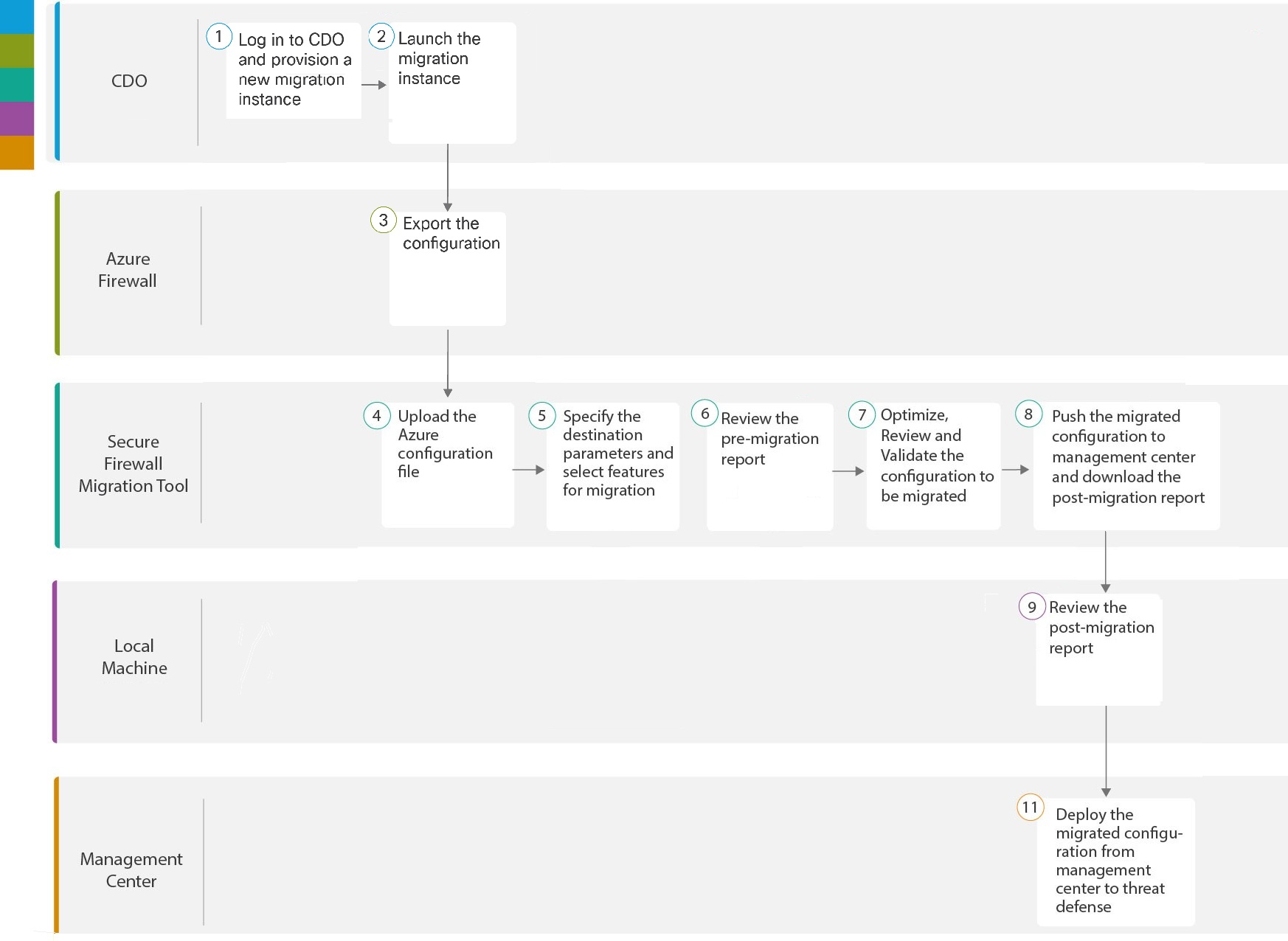Migrating Microsoft Azure Native Firewall with the Firewall Migration Tool in Security Cloud Control
The Firewall migration tool in Security Cloud Control allows migrating configurations from Azure firewall to threat defense devices managed by your cloud-delivered Firewall Management Center. You can manually derive the configuration file from your Azure firewall and upload it to the migration tool to begin with your migration. To learn about supported Azure firewall configurations, see Azure Configuration Support.
Select Source Configuration
On the Select Source Configuration page, choose Microsoft Azure and click Start Migration. Click Upload to choose the Azure configuration file and click Next.
Select Target
In the Select Target page, select the cloud-delivered Firewall Management Center provisioned on your Security Cloud Control tenant, and the threat defense devices managed by that management center are listed. You can choose the threat defense device you wish to migrate the configuration to, and proceed with the migration.
Note that the threat defense devices listed are displayed either as In Use or Available based on whether the device is being used in another migration instance. However, you can perform an override by clicking Change Device Status, selecting the device from the In Use list, and clicking Continue, which will make the device available for being selected as the target. Choosing Proceed without FTD pushes only NAT objects, ACLs, and port objects to the cloud-delivered Firewall Management Center. For more information about the commonly used ASA features and their equivalent threat defense features, see Cisco Secure Firewall ASA to Threat Defense Feature Mapping guide.
Caution | Changing the device status from In Use to Available impacts the ongoing migration instance that is using the device already. We recommend that you exercise caution when doing this. |
The flowchart that follows illustrates the step-by-step procedure for migration of Azure firewall configurations to threat defense devices:
To perform the procedure with more detailed steps, continue to Export the Configuration from Microsoft Azure Native Firewall in Migrating Microsoft Azure Native Firewall to Cisco Secure Firewall Threat Defense with the Migration Tool guide.

|
Workspace |
Steps |
|
|---|---|---|
|
|
Security Cloud Control |
Log in to your Security
Cloud Control tenant, and in the left pane, click and click the blue plus |
|
Security Cloud Control |
After your migration instance is ready, click Launch and choose Microsoft Azure. |
|
|
|
Azure Firewall |
Export the Azure configuration to the local system. To export the configuration from Azure firewall, see Export the Configuration from Microsoft Azure Native Firewall. |
|
|
Secure Firewall Migration Tool |
Upload the Azure configuration file exported from Azure firewall, see Upload the Microsoft Azure Configuration File. |
|
|
Secure Firewall Migration Tool |
In this step, you can specify the destination parameters for the migration. For detailed steps, see Specify Destination Parameters for the Secure Firewall Migration Tool. |
|
|
Secure Firewall Migration Tool |
Navigate to where you downloaded the pre migration report and review the report. For detailed steps, see Review the Pre-Migration Report. |
|
|
Secure Firewall Migration Tool |
Optimize and review the configuration carefully and validate that it is correct and matches how you want to configure the threat defense device. For detailed steps, see Optimize, Review and Validate the Configuration to be Migrated. |
|
|
Secure Firewall Migration Tool |
This step in the migration process sends the migrated configuration to management center and allows you to download the post-migration report. For detailed steps, see Push the Migrated Configuration to Management Center. |
|
|
Local Machine |
Navigate to where you downloaded the post migration report and review the report. For detailed steps, see Review the Post-Migration Report and Complete the Migration. |
|
|
Cloud-Delivered Firewall Management Center |
Deploy the migrated configuration from the cloud-delivered Firewall Management Center to threat defense. |
 button to start provisioning a new migration instance.
button to start provisioning a new migration instance.